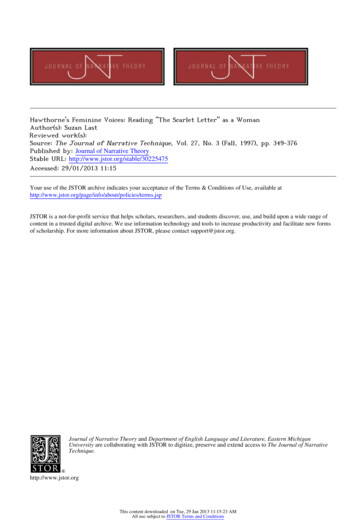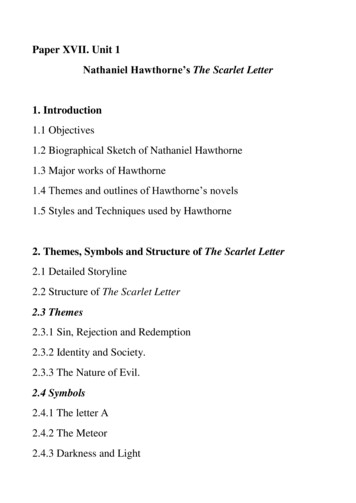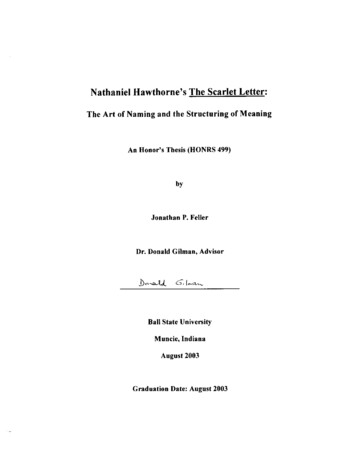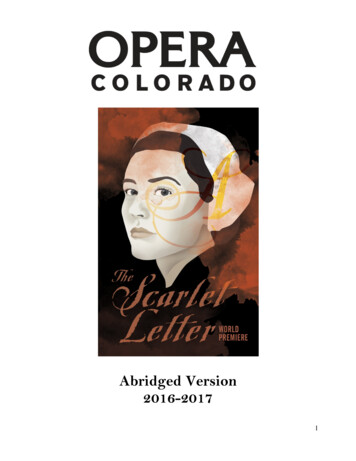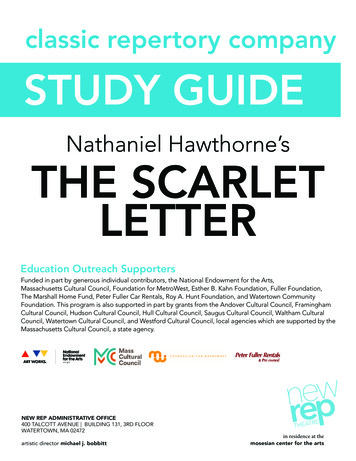
Transcription
classic repertory companySTUDY GUIDENathaniel Hawthorne’sTHE SCARLETLETTEREducation Outreach SupportersFunded in part by generous individual contributors, the National Endowment for the Arts,Massachusetts Cultural Council, Foundation for MetroWest, Esther B. Kahn Foundation, Fuller Foundation,The Marshall Home Fund, Peter Fuller Car Rentals, Roy A. Hunt Foundation, and Watertown CommunityFoundation. This program is also supported in part by grants from the Andover Cultural Council, FraminghamCultural Council, Hudson Cultural Council, Hull Cultural Council, Saugus Cultural Council, Waltham CulturalCouncil, Watertown Cultural Council, and Westford Cultural Council, local agencies which are supported by theMassachusetts Cultural Council, a state agency.NEW REP ADMINISTRATIVE OFFICE400 TALCOTT AVENUE BUILDING 131, 3RD FLOORWATERTOWN, MA 02472artistic director michael j. bobbittin residence at themosesian center for the arts
Biography ofNATHANIEL HAWTHORNE IN THE 1860SPHOTO BY MATHEW BRADYNathaniel HawthorneNathaniel Hawthorne was born in Salem, Massachusetts on July 4, 1804. His father died when hewas only four years old, and Nathaniel grew up with his mother and sisters in Salem and Raymond,Maine.In 1821, he began studying at Bowdoin College, where he was a self-admittedly lazy and rebelliousstudent. While Hawthorne was frequently fined for gambling, and resentful of the mandatory earlymorning religious services, during his Bowdoin years he fostered a number of meaningful andimportant friendships—perhaps most notably with Franklin Pierce, who went on to become the 14thPresident of the United States.After graduating in 1825, Hawthorne served as editor for the American Magazine of Useful andEntertaining Knowledge for three years. Hawthorne later took a job as a measurer at the BostonCustom House in 1839, where he tallied the quantities of foreign imports. A longtime bachelor, duein part to his reclusive nature, Hawthorne found his match in the illustrator and transcendentalist,Sophia Peabody. They were married on July 9, 1842. During their courtship, in 1841, Hawthorne beganworking at the Brook Farm in West Roxbury, Massachusetts—a transcendentalist Utopian communityfounded as an experiment in communal living, where participants sought a life of balance betweenmenial work and intellectual pursuit. Despite his initial enthusiasm, Nathaniel ultimately found thework to be so exhausting that it left him with no time or energy to write. After five months he left thecommune and began searching for new work.In 1842, the newly married Hawthorne couple moved into The Old Manse in Concord, Massachusetts.The Scarlet Letter Study Guide2
This marked the start of a whirlwind of creativityfor Hawthorne, during which he wrote the twentyone short tales that comprised his first publishedvolume, Twice Told Tales. While at the Mansein Concord, Hawthorne become a part of theintellectual community there, one that includedthe likes of Ralph Waldo Emerson, Henry DavidThoreau, and Margaret Fuller.In 1844, Sophia gave birth to their first child,Una. Unable to provide for his family with hiswriting, Hawthorne sought out a higher payingjob, eventually taking up employment at the SalemCustom House until Zachary Taylor was elected in1849. Taylor, a member of the Whig Party, replacedHawthorne, a Democrat, with one of his ownsupporters. Hawthorne, now bitter and with plentyof time on his hands, immediately began workon what would become The Scarlet Letter. Thismarked the start of another of his creative periods,during which he wrote The House of Seven Gables(1851) and The Blithedale Romance (1852). Thebooks were hailed instantly as important works byNATHANIEL HAWTHORNE IN 1840PAINTING BY CHARLES OSGOODthe academic community, putting Hawthorne onthe critical map, but they never became best-sellers. Whereas Harriet Beecher Stowe’s Uncle Tom’sCabin (1852) sold over 300,000 copies in its first year, The House of Seven Gables sold a paltry 6,710in the same period.Hawthorne, in dire need of a bigger salary than his poor book sales could afford him, wrote thebiography of his old friend Franklin Pierce prior to his election in 1852, which ultimately curried enoughfavor with the new President to secure Hawthorne the position of American Consul to Liverpool,Hawthorne’s highest-paying job, in 1853. As had previously been the case, when Hawthorne wasworking he found himself unable to write, but he was able to save enough money to support hisfamily. As he lived in Italy during his tenure as Consul, he collected notes and sketches that wouldlater become The Marble Faun, his final novel.In 1860, Nathaniel and his wife retired to Concord, but despite the period of rest he wrote very littleapart from occasional magazine and editorial pieces. On May 19, 1864, while on a tour with Pierce inPlymouth, New Hampshire, Hawthorne died in his sleep. His funeral was held on May 21st, and todayhe remains buried in Sleepy Hollow on what is known as Author’s Hill.Source: Person, Leland S. The Cambridge Introduction to Nathaniel Hawthorne. Cambridge: Cambridge UP, 2007. Print.The Scarlet Letter Study Guide3
PuritanicalPunishment:An American Legacy“The founders of a new colony, whateverUtopia of human virtue and happiness theymight originally project, have invariablyrecognised it among their earliest practicalnecessities to allot a portion of the virginsoil as a cemetery, and another portion asthe site of a prison.”HESTER PRYNNE AT THE STOCKS, AN ENGRAVEDILLUSTRATION FROM AN 1878 EDITIONSo begins Nathaniel Hawthorne’s The Scarlet Letter, a dark critique of the Puritan utopia’s cynical viewof human nature. The Puritans were religious refugees who came to the new world to escape religiouspersecution in England and practice their own brand of Protestantism. Their religion, influenced byCalvinism, taught that, upon birth, every child was either saved or damned; this is called pre-destination.This meant that “supernatural grace,” God’s gift of salvation and life everlasting, was not dependent onthe acts of the worshipper. Often religious tests were employed to determine whether one was chosenor fallen, not unlike the testing that Governor Bellingham and Reverend Wilson administer to Pearl,Hester’s illegitimate daughter. During this passage they look for some sign that Pearl is saved—a signshe should be taken from her mother to prevent her from being spoiled by Hester, whom they regardas a fallen woman.In Puritan theory, sins were divided into public and private. Private sins were those that were betweenthe penitent and God, best resolved by prayer. Public sins were sins that affected the social fabricof the Puritan colony – these included blasphemy, drunkenness, and even swearing. All public sinswere punished through rituals of public shame. A popular form of punishment for Puritan elders wasbranding, a method of marking the criminal with their crime for life. For instance, hot irons with theletters AD were pressed into the hands or cheeks of adulterers as a permanent mark upon their bodythat they could never remove. While Hester’s scarlet letter was made of cloth and not blood, it is worthyof note that the ministers are very concerned with ensuring her marking as sinner is permanent. It isDimmesdale that convinces Wilson and Bellingham to allow Hester to keep her child, not out of mercy,The Scarlet Letter Study Guide4
“WORKING ON THE CHAIN GANG” - GEORGIA, MARCH 8, 1937UNDERWOOD ARCHIVESbut because Pearl operates as a permanentreminder of Hester’s sin, for which she wouldbe ostracized.Many historians have remarked upon theimpact Puritan thought has had upon theAmerican prison system; replace the word“sin” with “crime,” and the Puritan philosophystill stands. While other nations have systemsbuilt upon the ideal of rehabilitation, theUnited States, influenced by its Puritan past,enforces penitence through hard labor.Today, many states have re-instituted policiesreflective of earlier “chain gang” rhetoric,whereby prisoners were used for often backbreaking labor under the premise that it wasthe best method of atonement for their crimes.We often hear politicians refer to prisonersneeding to “repay their debt to society.” Thislanguage reinforces what historian Brian Jarvisnotes as “a wholesale rejection of rehabilitativeideals and a return to a profoundly Puritanicalinsistence on punishment as retribution.”When a person commits theft, they become “athief.” They are no longer a person, but ratherCHAIN GANG IN BREVIN COUNTY, FLORIDA - 2013PHOTO BY ANDREW FORDbecome the crime they have committed.Some would say a modern version of thescarlet letter Hester is forced to wear currently exists on every job application in the United States,in the form of a box that felons are asked to check to notify their potential employer about their pastconvictions. Many activists, most notably supporters of the “Ban the Box” campaign, consider this amethod of stigmatizing criminals even after their sentence has passed, since they are required to reportthis information for the rest of their lives. In this way, the legacy of Puritan punishment, the same legacyHawthorne criticizes in his novel, can still be witnessed in the United States today.Sources:Rice, Chris, and Nathaniel Hawthorne. The Scarlet Letter. London: Penguin, 2000. Print.Jarvis, Brian. Cruel and Unusual: Punishment and U.S. Culture. N.p.: Pluto, 2004. Print.The Scarlet Letter Study Guide5
PoliticsAs UsualHenry David Thoreau was one of the leading AmericanTranscendentalist philosophers, but beyond that, he wasalso one of Nathaniel Hawthorne’s friends and inspirations.Hawthorne admired Thoreau for his dedication to selfreliance. His diaries are littered with praise for the quiet,introspective man with whom he enjoyed ice skating in thewinter and rowing in the summers of Concord.It is not unreasonable, then, to assume that Hawthorne hadread Civil Disobedience, published in 1849, when he beganwriting The Scarlet Letter, a searing critique of a hypocriticaltheocracy and its unjust laws. Civil Disobedience wasPORTRAIT OF HENRY DAVID THOREAUThoreau’s treatise on man’s relationship with government,BY BENJAMIN D. MAXHAMone that Thoreau characterized as antagonistic. In it, headvocated for a method by which moral objectors who felt that laws were unjust could protest thegovernment that had made them, in his mind, into machines. “It is not desirable to cultivate a respectfor the law, so much as for the right,” he wrote, continuing “the only obligation which I have a right toassume is to do at any time what I think right.”One of Thoreau’s primary reasons for objecting to government practices was the institution of slavery.Thoreau, an abolitionist, avidly believed that slavery was a moral wrong, and that any governmentthat supported it was, by its nature, unjust. He noted this when he wrote that “I cannot for an instantrecognize that political organization as my government which is the slave’s government also.” As aresult he refused to pay his poll tax because he refused to contribute money to a government he didn’tbelieve had the moral authority to demand his support. As a result, he was imprisoned for a short time.It is no coincidence, then, that Hawthorne’s heroine, Hester, rebels against an oppressive culturethat denies her humanity. She disagrees with their moral authority and civilly disobeys. She refuses togive up her co-adulterer, though she is promised it might lessen her sentence. She refuses to wear thescarlet letter in shame, instead embroidering it beautifully, an act of quiet protest. Hester acts by herown moral code, and, as was the case with Thoreau, this dooms her to be an outcast. In The ScarletLetter, Hawthorne takes a lesson from Thoreau in arguing that the only way to live independently, andby one’s own morality, is to live outside of society.Source: Thoreau, Henry. “Civil Disobedience.” By Henry David Thoreau. Ed. Morgan Saxby. Virginia Xroads, n.d. Web. 16 Sept. 2016.The Scarlet Letter Study Guide6
Classic Repertory CompanyProductionAs with any adaptation, our production of The Scarlet Letter will not be a word-for-word recreationof the novel. Our company of actors, designers and directors worked together to create a 60 minuteinterpretation for the stage that distills the essence of the story. We have our own unique group of actorswho have their own ideas and interpretations of the play. Because we have a cast of six actors, you’ll seeeach person playing multiple characters. Be aware of howthe actors use props, costumes and their bodies to becomesomeone new. We take our shows on the road to venues ofall sizes, which means our set needs to be light and mobile.We have lots of musicians in our cast, so we like to uselive music. Our actors are recent college graduates, whichmeans some of them will play characters much older thanthemselves, and some of them will play characters half theirage. All of these things make our production unique, in thehopes of offering you a new way to experience the story. Welook forward to talking with you after the show, and hearingCRC’S 2016-2017 PRODUCTION OF THE SCARLET LETTER,PHOTO BY CHRIS MCKENZIEabout your experience!Post Show Questions1. Select a moment from the play or novel that you found particularly moving. What makes itso effective? What devices does the author use to captivate you?2. Now that you have seen the play performed rather than read, how have your opinionschanged about the story, characters, or themes?Writing Prompt1. Look through your local newspapers or online for theatre reviews. Read a few, then writeyour own review of Classic Repertory Company’s The Scarlet Letter. Think about what partsof the show you enjoyed, what parts you didn’t understand, how the performers embodiedthe characters, and whether any production elements hindered or enhanced the telling ofthe story. Feel free to send the review over to us when you’re done!The Scarlet Letter Study Guide7
THE SCARLET LETTER classic repertory company Funded in part by generous individual contributors, the National Endowment for the Arts, . Hawthorne, in dire need of a bigger salary than his poor book sales could afford him, wrote the biography of his old friend Franklin Pierce prior to his election in 1852, which ultimately curried enough .


